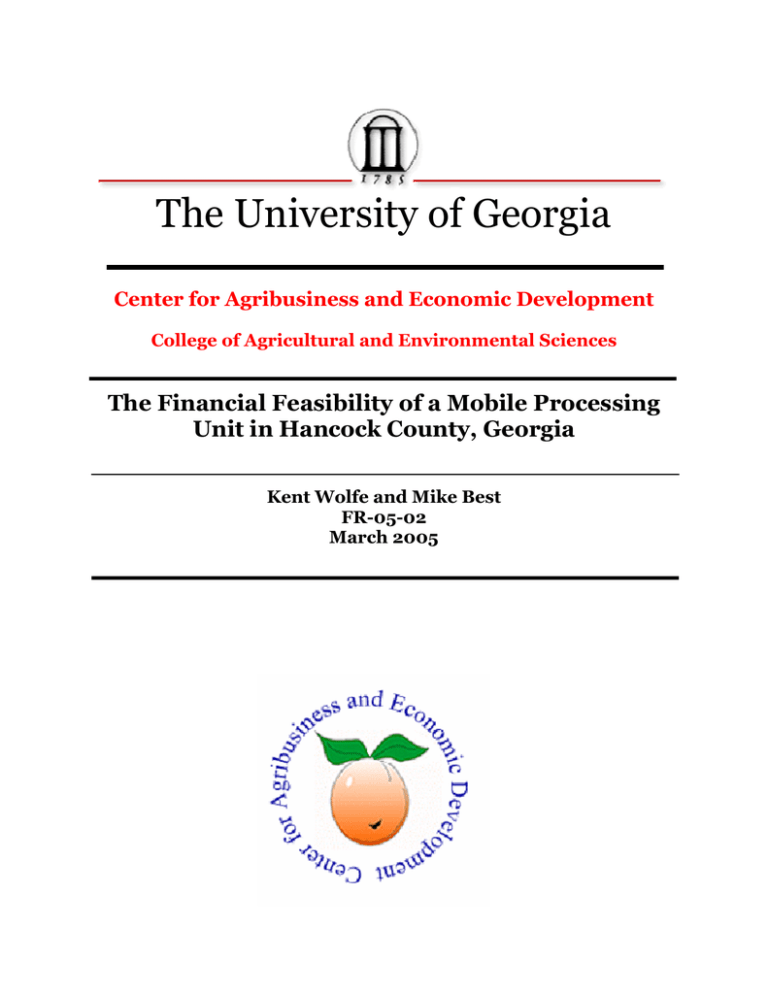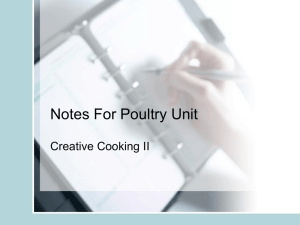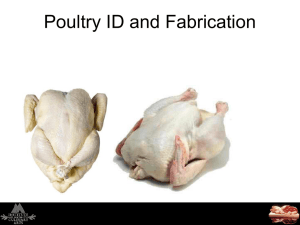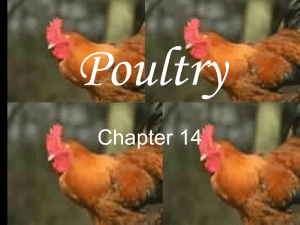The University of Georgia The Financial Feasibility of a Mobile Processing
advertisement

The University of Georgia Center for Agribusiness and Economic Development College of Agricultural and Environmental Sciences The Financial Feasibility of a Mobile Processing Unit in Hancock County, Georgia Kent Wolfe and Mike Best FR-05-02 March 2005 The Financial Feasibility of a Mobile Processing Unit in Hancock County, Georgia Page Introduction......................................................................................................................................1 USDA Regulations...........................................................................................................................1 Market Analysis ...............................................................................................................................4 Target Market.......................................................................................................................4 Area Market Potential ..........................................................................................................4 Packaging.............................................................................................................................5 Market Potential...................................................................................................................5 Pricing & Estimated Gross Revenue per Bird .....................................................................6 Marketing.............................................................................................................................6 Financial Analysis................................................................................................................8 Conclusions.................................................................................................................................12 The Financial Feasibility of a Mobile Processing Unit in Hancock County, Georgia Kent Wolfe and Mike Best March, 2005 I. INTRODUCTION Hancock and the surrounding counties in Georgia have a core group of poultry producers that are interested in forming a cooperative for the purpose of sharing the cost of purchasing a mobile processing unit to process their live chickens. The poultry producers feel that there is consumer market base that seeks alternative sources of poultry, small game birds, fish, and small animal meats. In addition, these producers believe there are restaurants, farmers’ markets, and individual consumers seeking high quality products that are locally accessible. Additionally, this demand is limited to already-processed birds. The ability of small farmers to meet this demand depends on ready access to value-added processing opportunities. This report examines the feasibility of operating a mobile processing unit (MPU) by this Hancock County group. These producers have experience in producing live poultry but have no experience in processing these chickens for sale to the general public. The Center for Agribusiness and Economic Development has been asked to perform a feasibility analysis for these Hancock County poultry producers. There is a model processing unit that is owned by the Heifer International, Inc. that this study cost estimates were based. This report is divided into three sections with the first being an overview of market potential for poultry, game birds, aquaculture, and other small livestock for direct consumer marketing. The second section is devoted to a cost analysis of the MPU costs of operation and potential to generate profit. II. USDA Regulations The following are written responses to questions pertaining to poultry slaughtering in Georgia. They have a focus on slaughtering poultry via a mobile processing facility. The response letter was dated March 14, 2005. 1. Does the USDA exemption allowing an individual to process up to 20,000 birds annually apply in Georgia? YES 2. Does the exemption apply to small scale poultry producers using a cooperatively owned mobile processing facility? YES 3. The poultry must be deemed healthy before slaughtering, how do the producers go about having their chickens deemed healthy? Under the poultry exemption it is the responsibility of the producers to assure that their chickens are healthy at the time they are slaughtered. 1 4. Could a cooperative own a mobile processing facility and rent it out to Private Businesses to process poultry? Each business would like to process up to the 20,000 bird limit annually? I am not quite sure how to address this question. The cooperative would be responsible for 5. Does the 20,000 exemption mean the business can process up to 20,000 chickens on the farm using the mobile processing facility and market them to buyers such as hotels, restaurants, and directly to consumers without have the birds federally inspected? Yes, as long as the birds are properly labeled with the following: Name, address and PL9492 has to appear on the label. 6. What are the regulations associated with processing other species, quail, fish, rabbits, turkey, Cornish hens, etc.. in the mobile processing facility? Is there a maximum number of units that can be processed without falling under regulation? Quail and rabbits are not amenable to inspection. Fish is under the jurisdiction of the Food and Drug Administration. Turkeys and Cornish hens have to have Federal inspection. 7. Can you send me a copy of the Georgia Exemption? See the following chart. 8. Can you please send me a set of guidelines that these producers can follow to peruse slaughtering and marketing poultry products in a mobile processing facility? See the following table. 9. Can you send me information on waste disposal? Both liquid waste as well as solid waste that would be generated from the processing facility. I would suggest that you contact the Environmental Protection Agency and the Georgia Department of Agriculture for guidance. For More information on these and other poultry processing regulations please contact: Dr. Smith, District Manager USDA, FSIS Atlanta District Office Suite 3R90 100 Alabama Street Atlanta, Georgia 30303 (404)562-5900 2 3 III. MARKET ANALYSIS A survey administered to 1,000 people in Kansas City, Missouri collected information that can be used to evaluate the market for pastured poultry products. Three consumer groups were sent surveys to gauge their purchasing process, as well as perceptions of pastured poultry. Target Market According to the results in the aforementioned study, free range chicken consumers are typically between 45 and 54 years of age. Half of the free range chicken consumers indicated they had children in the home. In addition, the free range chicken respondents were generally college educated and had household incomes exceeding $75,000 annually. In summary, the free range poultry consumer appears to be middle aged, affluent, college educated people. Area Market Potential Using the target market data identified above, it is possible to determine the number of people within a defined market area with similar demographic data. The study will look at the surrounding area as one market area and then expand the area to include Atlanta, Augusta and Macon. Hancock County is situated near these three large metropolitan areas and has the potential to supply free range poultry to consumers and upscale restaurants located in these markets. The information presented in Table 1 indicates that a significant population base resides within 100 miles of Hancock County. Over six million Georgian’s reside within 100 miles of Hancock County. 4 Table 1. Population and Demographics of Area Residents Population (2004) Gender Male Female 30 118,573 Miles From Sparta 60 1,157,880 100 6,003,347 59,959 58,614 562,304 595,576 2,950,087 3,053,260 36.3 33.7 33.4 Race/Ethnicity White Black Asian Hispanic Other 60,819 53,748 699 1,660 1,647 710,134 378,625 15,475 27,410 26,236 3,506,299 1,789,885 152,675 320,065 234,423 Education Attainment Less Than High School High School Some College Associate Degree College Graduate Degree 35,323 43,252 18,484 4,561 10,487 6,466 273,934 377,747 222,899 57,557 138,942 86,800 1,204,190 1,633,295 1,212,158 329,851 1,065,105 558,749 Household Income Less than $15,000 $15,000 to $24,999 $25,000 to $34,999 $35,000 to $49,999 $50,000 to $74,999 $75,000 to $99,999 $100,000 to $124,999 $125,000 to $149,999 $150,000 to $199,999 $200,000 and Over 28,200 18,444 16,411 18,658 19,414 8,412 3,859 1,541 1,361 2,272 226,120 159,967 155,886 199,338 217,886 101,373 44,716 20,169 14,765 17,659 907,773 701,734 738,687 997,641 1,197,106 645,868 336,487 167,624 148,905 161,522 54,461 40,869 56,638 45,728 Median Age (years) Average Income ($) Median Income ($) 5 The free-range chicken consumers reported that they eat chicken two times a week on average as either a main dish or ingredient. Packaging The group is currently planning on selling whole processed chickens. However, this may not be the best product form to sell to target market as they are affluent and looking for quality convenience products. It is important to package products in accordance with consumers’ tastes and preferences. Table 2 provides insight into how free-range chicken consumers purchase chicken. The results suggest that free-range chicken consumers are particular in regard to the types of chicken products they frequently purchase. Free-range chicken consumers are more likely to purchase white meat products that require little or no preparation, boneless chicken breast. Given that the free-range chicken consumer is affluent and may have children in the household they are likely to pay for convenience foods. Table 2. Consumers Purchase Frequency of Chicken Parts Chicken Part Average Interpretation Boneless Breast 1.37 Often Whole Chicken 1.79 Occasionally Breast with Ribs 2.27 Occasionally Thigh 2.63 Rarely Drumstick 2.77 Rarely Wings 3.15 Rarely Source: “Consumer Preferences for Organic/Free Range Chicken”, Liz Neufeld, Research associate the Tait Advisory LLC, Agricultural Market Resource Center, 2002 Given the results shown in Table 2, there may be a problem with selling dark meat products and products that require additional preparation before being served as a meal or included as an ingredient. It appears that the free-range consumer may be a health-conscious person that prefers to consume which poultry meat. In fact, research has demonstrated that consumers who purchase free-range chicken do so because it does not contain antibiotics, is healthier and has a better taste than conventionally produced poultry. Market Potential Overall, per capita meat consumption in the United States grew 8.7 percent from 1980 to 2000, from 180 to 195 pounds of meat per person, on average. From 1980 to 2000 per capita consumption of chicken grew 68 percent to 53 pounds annually. We can use this figure to estimate the total amount of chicken consumed on a per capita basis for affluent people residing in 30, 60 and 100 miles of Hancock County. Calculating the total market potential for these areas 6 for affluent people, household incomes over $75,000 annually, it is possible to determine whether the market is sufficient enough to support the number of chicken proposed being processed on an annual basis, Table 3. Table 3. Estimated Market Potential for Affluent Consumers in Identified Market Areas Miles Income Group (households) 30 60 100 $75,000 to $99,999 8,412 101,373 645,868 $100,000 to $124,999 3,859 44,716 336,487 $125,000 to $149,999 1,541 20,169 167,624 $150,000 to $199,999 1,361 14,765 148,905 $200,000 and Over 2,272 17,659 161,522 Total 17,445 198,682 1,460,406 US Per Capita Consumption of Chicken 53 pounds 53 pounds 53 pounds Estimated Annual Area Consumption of Chicken 924,585 (lbs) 10,530,146(lbs) 77,401,518(lbs.) Given the estimated total pounds of chicken consumed annually in the three defined area, it appears that there is a large enough population consuming chicken to establish a free-range chicken market. However, the percentage of these people who consume free-range chicken is not known. An additional concern may be the concept of packing a whole bird as opposed to cuts. The target consumer may be less willing to purchase a whole bird yielding a much more narrowly defined niche market. Pricing and Estimated Gross Revenue per Bird According the results of the University of Wisconsin’s Center for Integrated Agriculture Systems (CIAS), farmers are charging an average of $1.90 per pound for a whole processed free-range chicken. Assuming an average of 4 pounds per carcass processed and the $1.90 per pound selling price, each bird would generate $7.60. Marketing The study results indicated that the majority of respondents (65 percent) who reported that they have never purchased free range chicken did so because they did not know much about it or even that it was available. Therefore, there may be a need to develop an education component when marketing the free-range chicken to consumers who are unfamiliar with free-range or pastured poultry products. The free-range consumer is not willing to give up taste, appearance and color and USDA approval purchase free-range poultry products. According the Kansas City study, these factors are considered to be very important with regard to consumer’s decision to purchase chicken products. 7 This information means that the cooperative will have to provide a tasty product with a healthy appearance and color that has been processed in an approved USDA facility with no artificial ingredients or additives. The demographic profile of the target market suggests that the poultry will have to be marketed in affluent areas and through retailers that cater to more affluent customers. Most supermarkets draw their customers from within a five mile radius of their store. Therefore, it is easy to determine the demographic composition of an area around a particular store. In addition, supermarket chains keep detailed information on their customers and can provide information revealing which stores cater to affluent customers. When marketing the free-range poultry it is important to remember that the target market is looking for a product free of antibiotics and hormones, that is healthier and tastes better than conventionally produced chicken. This information needs to be incorporated in to the product packing as well as all marketing and promotional materials to effectively reach the target market. 8 IV FINANCIAL ANALYSIS The remaining section of this report focuses on the financial feasibility of operating the MPU to process the number of birds that the Hancock County group is expecting to produce and process annually. The operating budget for the MPU is built on limited historical evidence. There is a growing list of poultry, small game, and aquaculture producers who have an interest in using mobile processing units. It is expected that this type of MPU has the potential to be used by farmers producing other small game as well. Although anecdotal and observational information indicate that there is growing interest in mobile processing units, this feasibility study is built on small usage numbers for its first year and limited the processing of chickens. Operating budgets for the production of pasture raised poultry were used as the starting point for this analysis. Production costs were taken from an analysis done at Kansas State University for the production of free range poultry. Liz Neufeld, as part of her master’s thesis, determined the costs of producing free range chicken and the costs associated with this production are in the appendix. In order for a breakeven analysis to be completed, the total number of chickens being processed annually must be estimated. For the Hancock County Cooperative it was estimated to be around 20,000 birds in the first year with the expectation for it to potentially reach 100,000 in as few as five years. Table 4 illustrates predicted demand for use of the MPU in the course for year one and five. Although it is anticipated that small animals other than free range poultry will be processed in this MPU, the most frequent user of the unit is expected to be poultry. Table 4. Predicted Year 1 and Year 5 Usage of Mobile Processing Unit Usage Events by Days Free Range Poultry Percentage Usages Year 1 50 days 16% Year 5 250 days 78% Fixed costs were determined based on current annual expenditures. The following table shows these fixed expenses on both a total and per bird basis. The per-bird units were calculated using an annual production rate of 20,000 birds. Depreciation on the mobile processing unit was the most expensive fixed cost at just over $7,000 annually. Interest was second most costly expense at just over $2,500. Total annual fixed costs came in at just over $11,000. Table 5. MPU Fixed Expenses (Assuming 20,000 Birds) Taxes & Insurance Per Bird Total $ 0.04 $ 770 Depreciation – Plant Equipment Interest on Investment – Health Department Fee $ $ $ 0.37 0.13 0.01 $ $ $ 7,432 2,696 150 Total $ 0.55 $ 11,049 9 Labor cost per bird would be one of the most expensive direct costs associated with utilizing this MPU. Table 6, below shows the total labor cost for processing 20,000 birds and what that would mean per bird as well. It is expected that an individual can process 100 birds in an eight hour day. With four workers processing birds at the same time, this would result in 400 birds being processed daily. Table 6. MPU Direct Labor Expenses (Assuming 20,000 Birds) Labor Cost Total Direct Labor Expense Per Bird $ $ 0.80 0.80 Total $ $ 16,000 16,000 Additional direct expenses were also estimated based on limited usage of the MPU when processing poultry and applied across species. Table 7 shows these costs which include LP gas ($0.04/bird), electricity (which includes operation of scalder, plucker, and air conditioners at $0.18/bird), water for processing ($0.10/bird), septic tank disposal ($0.015/bird), miscellaneous supplies ($0.30/bird for ice, sanitation & cleaning supplies, labels, etc.). Repairs and maintenance which were estimated to be three percent of the cost of the MPU, ended up being a little more than $2,300. Table 7. MPU Other Direct Expenses (Assuming 20,000 Birds) Electricity LP Gas Water Miscellaneous Supplies Septic Disposal Repairs & Maintenance (3% of Equipment Cost) Total of Other Direct Costs Per Bird Total $ $ $ $ $ 0.18 0.04 0.10 0.30 0.02 $ 0.12 $ $ $ $ $ $ 2,311 $ 0.75 $ 3,600 800 2,000 6,000 300 15,011 Table 8 shows the MPU expenses associated with the 20,000 bird production level. If labor expense, other direct expenses and total fixed costs are all summed, the total annual production costs associated with operating this MPU is just over $42,000. This table also shows the breakeven cost on a per bird basis, when processing 20,000 birds annually. This cost per bird is $2.10, and this represents the cost that the chicken producers would have to pay to have their birds processed utilizing this MPU. This $2.10 cost assumes that the labor won’t be provided by the farmer, if this was the case then the farmer would only have to pay $1.30 for the use of the facility on a breakeven analysis. 10 Table 8. MPU Expenses (Assuming 20,000 Birds) Total Direct Labor Expense Total Other Direct Costs Total Fixed Costs Total Cost Per Bird $ $ $ $ 0.80 0.75 0.55 2.10 Total $ $ $ $ 16,000 15,011 11,049 42,060 Tables 9 through 14 outline the expenses that are associated with purchasing a mobile processing unit. Some of these costs can be avoided, however, their may be additional charges as well and therefore the estimates given are considered safe. Table 9 shows the equipment that would need to be purchased in order to operate this MPU. The seventeen items listed cost a little over $20,500 with the ice maker being the most expensive piece of equipment. Table 9. Equipment Listing and Cost Ice Machine Stunning Knife Chill tanks Pumps Shelves Chicken lung remover Turkey lung remover Misc. Equip Pinning knife Sharpening Steel Aprons Shackle trolley Picker Scalder Bleed cone rack Pressure Washer Bleed cones & Assy. Total Equipment $ 7,300.00 $ 1,650.00 $ 510.00 $ 815.00 $ 499.00 $ 11.00 $ 11.00 $ 209.00 $ 13.00 $ 15.00 $ 35.00 $ 110.00 $ 3,952.00 $ 2,950.00 $ 250.00 $ 1,813.00 $ 363.00 $ 20,509.00 The Mobile Processing Unit required that a basic goose-neck trailer be purchased and modified. As shown in Table 10, the basic trailer cost a little over $15,000 and the initial modifications cost almost $22,000 for a total of $36,871. 11 Table 10. Mobile Processing Unit Costs Basic Trailer Initial Modifications Trailer cost (with basic modifications): $ 15,054.00 $ 21,817.00 $ 36,871.00 Additional modifications would be required to the trailer for its use as a Mobile Processing Unit. These additional modifications included both mechanical and design modifications. The total modification cost would be just under $5,000 for the MPU and is shown below in Table 11. Table 11. Additional Trailer Modifications Table & Shackle Rack & Door Drain Hose & Cam Locks Tie Downs & Storage Bins & Black Eqmt. Flu Pipe Total Modifications Final Design Modifications $ $ $ $ $ $ 2,000.00 350.00 450.00 325.00 3,125.00 1,800.00 Initial Modifications $ 4,925.00 Additional equipment costs for the MPU are shown in Table 12. These costs include items like knife holders, brooms, thermometers and poultry coups. The total cost for these items is $3,433. Table 12. Inside Equipment Cost Knife holders, First aid kit, Sanitizer Disinfectant, Degreaser, Scrub brushes Brooms, Trash cans, Pails Thermometers, Scales, Bags Bag stapler, Gloves, Pad locks Shears & scissors, Step stools, Poultry coups Total $ 3,433.00 Several other items that were included in this analysis that may or may not be necessary are listed in Table 13. Depending on the site where the MPU will be used, the costs could be lower or higher. If there is existing septic disposal and it is allowable for the waste from the processing unit to be dumped into the existing sewer, there will be an additional charge to hook up to the 12 existing sewer. The docking station includes a concrete pad where part of the processing will take place. The total for these additional one-time costs is $6,250. Table 13. Additional Operational One Time Costs Trailer hitch for HPI Truck to haul Docking station for Trailer Legal fees and Insurance Tags & License Total Additional Operational One Time Costs $ 450.00 $ 2,000.00 $ 3,500.00 $ 300.00 $ 6,250.00 Table 14 just summarizes the costs of the mobile processing unit. The table shows that the total cost of the mobile processing unit with sales tax is $77,027.16. Table 14. Total Equipment Costs Equipment Listing and Cost Mobile Processing Unit Costs Additional Trailer Modifications Inside Equipment Cost Additional Operational One Time Costs Equipment Subtotal Sales Tax 7% Grand Total for Equipment $ 20,509.00 $ 36,871.00 $ 4,925.00 $ 3,433.00 $ 6,250.00 $ 71,988.00 $ 5,039.16 $ 77,027.16 V. CONCLUSIONS The processing facility appears to be economically viable for 20,000 birds with the assumptions outlined in the previous sections. Increasing the number of birds processed to 100,000 annually will drastically decrease the total cost per bird. The ability to sell 100,000 whole birds at a premium price may become an issue and further analysis may be needed before the operation is expanded significantly. It is important to estimate the net return per bird to determine if the business is economically feasible. Assuming that the total cost of processing a bird is $2.10 and that each bird yields a four (4 ) pound carcass that sells for $1.90 per pound, each bird will net $5.50. However, remember that this return of $5.50 per bird does not take into account the costs associated with producing a bird ready for slaughter. According to research done by Neufeld (2002), the cost of producing pasture raised poultry is estimated at $4.02 per bird, excluding labor costs. Subtracting this figure from the $5.50 calculated above the return to labor is $1.48 per bird. 13 Estimated net return to labor at 20,000 birds annually is $29,600. However, this figure assumes that the birds can be sold for a premium and not as a commodity product. 14 The Center for Agribusiness & Economic Development The Center for Agribusiness and Economic Development is a unit of the College of Agricultural and Environmental Sciences of the University of Georgia, combining the missions of research and extension. The Center has among its objectives: To provide feasibility and other short term studies for current or potential Georgia agribusiness firms and/or emerging food and fiber industries. To provide agricultural, natural resource, and demographic data for private and public decision makers. To find out more, visit our Web site at: http://www.caed.uga.edu Or contact: John McKissick, Director Center for Agribusiness and Economic Development Lumpkin House The University of Georgia Athens, Georgia 30602-7509 Phone (706)542-0760 caed@agecon.uga.edu The University of Georgia and Fort Valley State University, and the U.S. Department of Agriculture and counties of the state cooperating. The Cooperative Extension Service offers educational programs, assistance and materials to all people without regard to race, color, national origin, age, sex or disability. An equal opportunity/affirmative action organization committed to a diverse work force. FR-05-02 March 2005 Issued in furtherance of Cooperation Extension Acts of May 8 and June 30, 1914, the University of Georgia College of Agricultural and Environmental Sciences, and the U.S. Department of Agriculture cooperating. J. Scott Angle, Dean and Director





